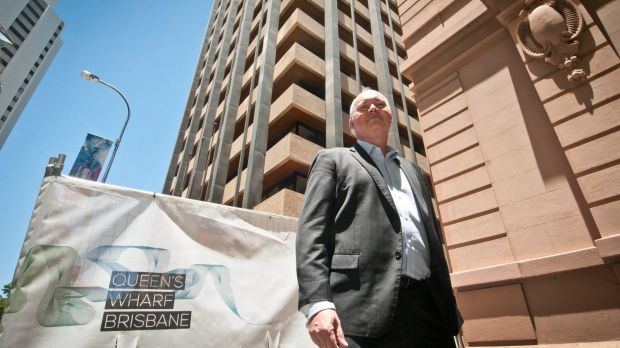Over the coming year, three of Brisbane's landmark buildings will disappear from view as they make way for the new Queen's Wharf resort, casino and entertainment precinct.
But those who hoped for the spectacle of implosions or giant wrecking balls would be sorely disappointed.

For Destination Brisbane project manager Simon Crooks, the demolition came down to two words – slow and methodical.
At 16 storeys above the ground, the old Executive Building at 100 George Street was thought to be the tallest building so far demolished in Brisbane.

But before the wreckers moved in, the tower, along with 80 George Street and the Neville Bonner Building, would all have to be thoroughly checked for asbestos before being "soft stripped", which would see all remaining furniture, carpets and fittings removed.
The first external signs of demolition were expected to be seen within weeks.
"(The public) won't see a huge amount for the next month or two, because it's all internalised," Mr Crooks said.
"Then, (the demolition of) the Neville Bonner building, the (EB's) annexe and the connection to the Printery will start first and flow through to the Executive Building.

"In April, we will be expecting the team to start demolishing 80 George."
More on that delay later.
The first sign of demolition would be noticeable to Riverside Expressway commuters, when the Neville Bonner Building's precast shade structures are removed by crane.
At the same time, away from public sight, what Mr Crooks called the "careful disconnection" of annexe and the heritage-listed Printery would begin.
This would be the most delicate operation in the entire demolition process, with a lot of the work done by hand.
There were no such problems over at the Executive Building, where 4.5-tonne "munchers" would be lifted up by crane to begin their carnage through the former seat of Queensland executive power.
Not that people will know down at ground level.
"What you'll see is the scaffold stays quite high while things get demolished down, then the scaffold will jump down a bit," Mr Crooks said.
"So you'll see sudden movements (of the scaffold) going down maybe a couple of levels at a time.
"You mightn't see much movement in a week, you'll just see it slowly get eaten down."
The same process will be underway at the Neville Bonner Building, which will be similarly encased in covered scaffolding, although the process was not expected to take as long as it will at the Executive Building.
"It's a very traditional method of demolishing, very slow," Mr Crooks said.
"But there's less chance of big impact."
The demolition delay at 80 George Street, the building that sprawled over two city blocks and straddled Margaret Street, was due to an important function it served in the precinct.
"Eighty George Street has a central energy plant, which has a lot of Energex systems in there and that supplies all of this precinct, so we've got to separate that out so Energex can decommission it beforehand," Mr Crooks said.
"It also supplies the lighting for the Goodwill Bridge, so before any buildings are demolished we have to do all the diversions with Energex, which is what you're seeing at night with the works around the pavement, to pull the systems out of there and divert it out so we don't lose continuity in the external precinct."
Mr Crooks said 80 George Street's bridge over Margaret Street would be the last part to go.
Once the floors above the road were "munched" and carted away, the large, 40-tonne beams that held the building in place would be removed by a 450-tonne crane.
Debris from the three major buildings will be tipped into lift cores, where it would run through a shute to waiting trucks on William Street.
At the height of activity, about 100 trucks will go through every day, with some restrictions during peak traffic times.
As for where the expected 140,000 tonnes of debris would end up, Mr Crooks said that was a matter for Destination Brisbane's Probuild.
"There are a couple of areas where this construction debris will be crunched up and reused as fill and one of them's the airport, because the airport needs a lot of fill," he said.
But any hopes pilots might have had about landing a plane on the old Executive Building appeared to be dashed.
Brisbane Airport Corporation spokeswoman Leonie Vandevan said while negotiations were underway for material to come to the site, it would not be for the new runway project.
"It may occur for some future project, but there's nothing currently planned or agreed for demolition material to come to BNE (Brisbane Airport)," she said.
Still, Mr Crooks said the majority of debris from the site – 90 per cent – would be recycled in some way.
All things going to plan, Mr Crooks said the site would be entirely razed by the end of 2017, sparing the heritage buildings on the site.
Test pits have already been dug around some of the site's heritage buildings, ahead of them being braced against vibration and possible damage associated with both the nearby demolition and building processes.

0 comments
New User? Sign up